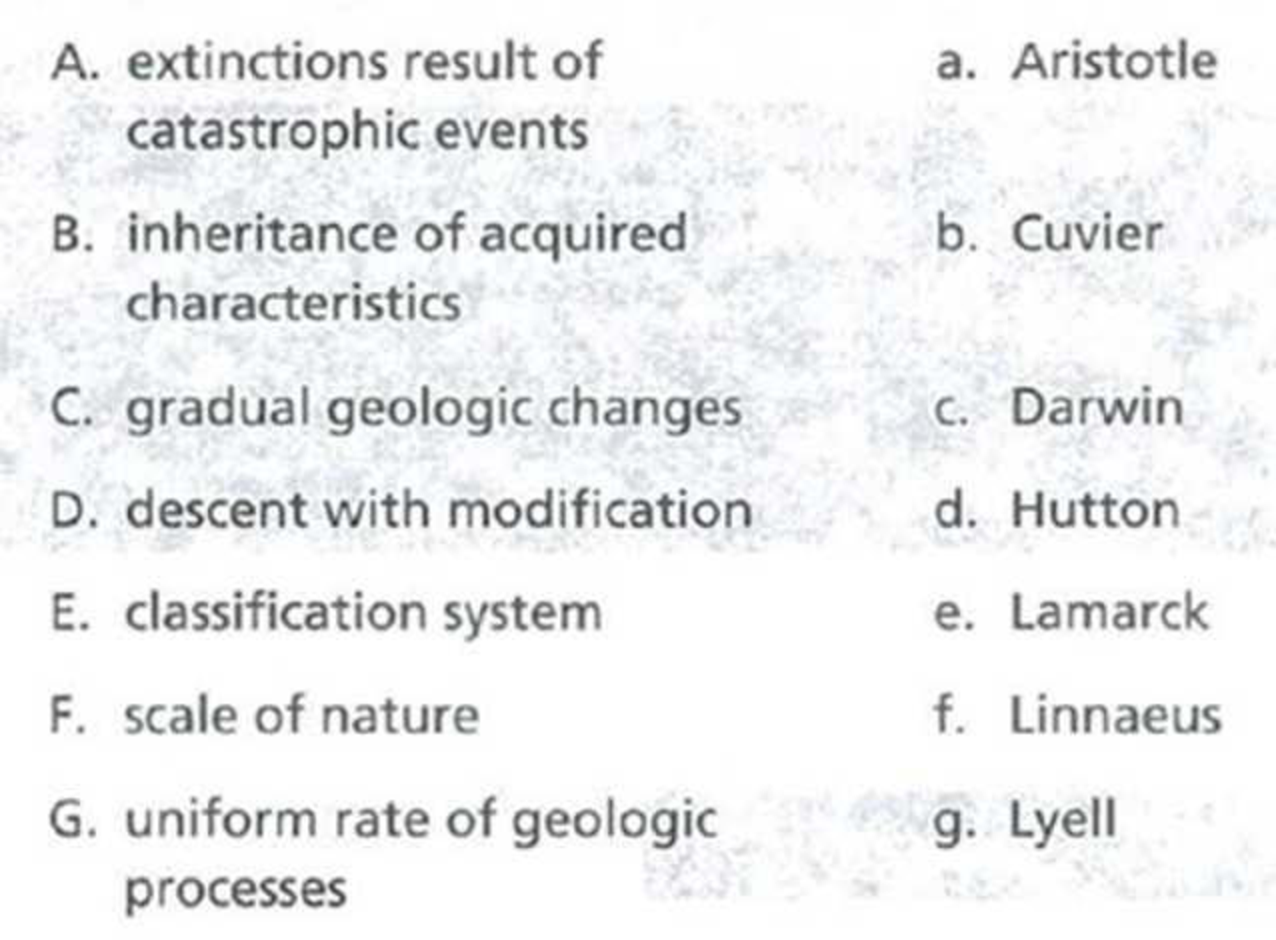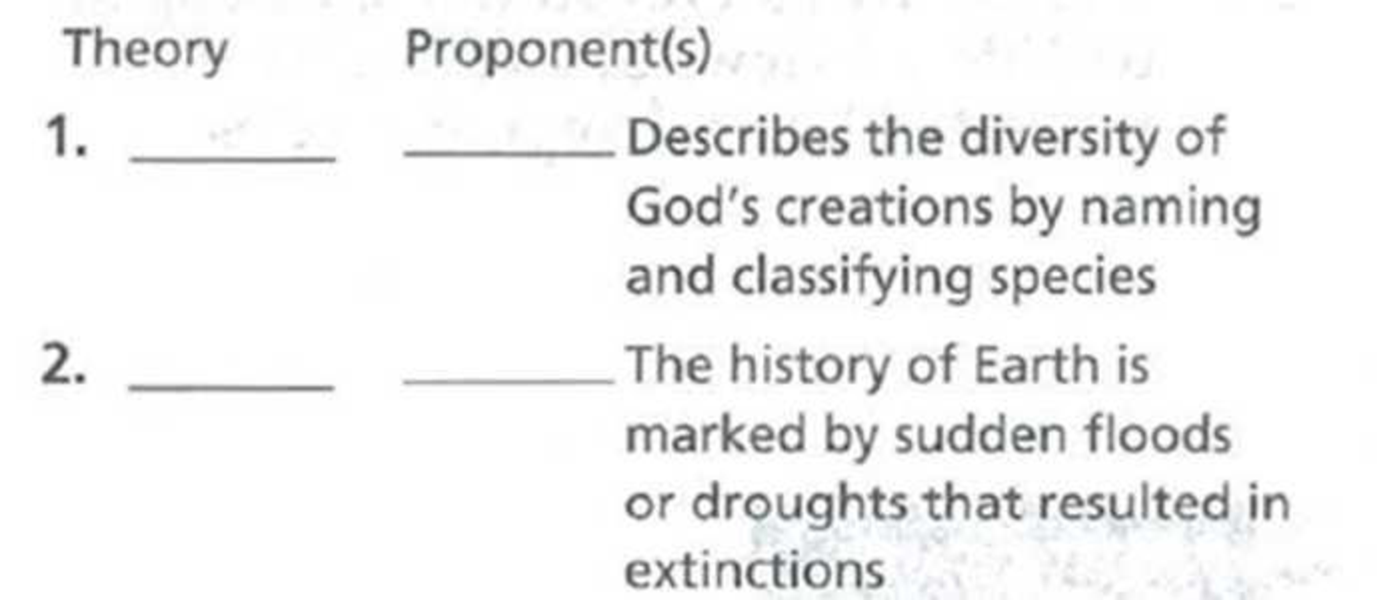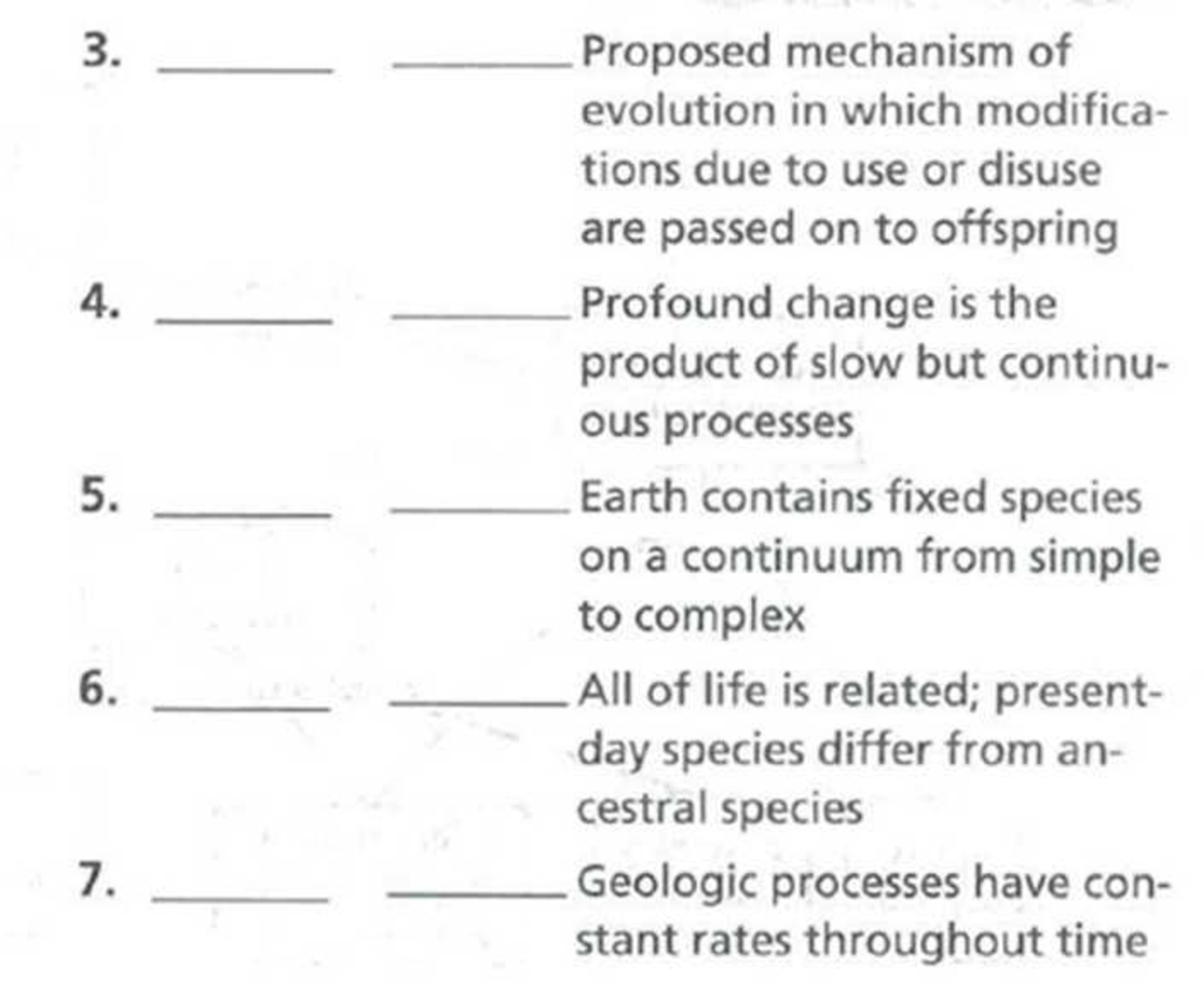
Concept explainers
- a. Write the capital letter representing the theory or philosophy and the lowercase letter(s) representing its proponent(s) in the blanks preceding the following seven descriptions.



- b. Now place the people listed in a through g in chronological order according to the dates of their ideas regarding change over time.
__________
a.
To match: The theory or philosophy with their respective proponents.
Introduction: Our earth was formed before 4.6 billion years from the sun with continuous bombardment of huge rocks and ice. When the Earth was formed, chemical evolution began, which formed organic molecules. Organic molecules led to evolution of protobionts.
Answer to Problem 1IQ
| S. No | Theory | Proponents |
| 1 | E. classification system | f. Linnaeus: Describes the diversity of God’s creations by naming and classifying species. |
| 2 | A. extinctions result of catastrophic events | b. Cuvier: The history of Earth is marked by sudden floods or droughts that resulted in extinctions. |
| 3 | B. inheritance of acquired characteristics | e. Lamarck: Proposed mechanism of evolution in which modification due to use or disuse are passed on to offspring. |
| 4 | C. gradual geologic changes | d. Hutton: Profound change is the product of slow but continuous processes |
| g. Lyell: Profound change is the product of slow but continuous processes | ||
| 5 | F. scales of nature |
a. Aristotle: Earth contains fixed species on a continuum from simple to complex |
| 6 | D. decent with modification | c. Darwin: All of life is related; present day species differ from ancestral species |
| 7 | G. uniform rate of geologic processes | g. Lyell: Geologic processes have constant rates throughout time |
Explanation of Solution
- 1. Classification system theory was proposed by Linnaeus. This theory describes the diversity of God’s creation by their different naming and classification of species.
- 2. Cuvier explained the philosophy that extinctions are the result of catastrophic events. He explained that extinctions and differences as the history of earth, those were marked by sudden catastrophic events. These are the indicatives of evolution.
- 3. Lamarck explained the mechanism of evolution by two principles. The two evolution principles are the use and disuse of body parts that leads to development or deterioration, and the inheritance of acquired characters.
- 4. Hutton and Lyell proposed the theory of gradual geologic changes. They explained the theory that profound changes occurs as per cumulative but continuous processes.
- 5. “Aristotle (384-322 BCE)” studied the closeness of different organisms and categorized them according to their nature of complexity. One of the significant observations by Aristotle was the shift of organisms from a simple state to a perfect state.
- 6. Darwin summarized his view of life in a phrase “descent with modification” in terms of unity and diversity. Sharing many characteristics by organisms made Darwin to observe unity in their lives. The unity in their lives was due to sharing common ancestors living in their remote past. Living in different habitats, these descendants gradually acclimatize to various modifications that enable them to adapt to specific environments.
- 7. Lyell proposed the theory of uniform rate of geologic processes. This theory explained that the geologic processes function at a constant rate and continue in the present.
b.
To place: The above listed people in a through g in chronological order as per the dates of their ideas regarding the change over time.
Introduction: Evolution is a process that has been taking place since the origin of life. Species have evolved themselves according to their needs with their changing surrounding environment. To explain these changes taking place in different species of plants and animals, different theories have been put forward from time to time.
Answer to Problem 1IQ
Correct answer: The correct chronological order for the people given is as follows:
Explanation of Solution
The chronological order as per the dates for the above listed people in a through g for their ideas regarding the change over time are as follows:
- Aristotle (384-322 BCE) proposed the theory of scales of nature.
- Then in the 1700s, Linnaeus developed the idea of binomial system of naming.
- Hutton proposed the theory of gradualism on 1795.
- Lamarck proposes the hypothesis of evolution on 1809.
- Cuvier on 1812 publishes his expensive studies of vertebrate fossils.
- Lyell proposes the theory of geological changes on 1830.
- Then the greatest phase of evolution, “descent with modification” invented by Darwin on 1844.
Want to see more full solutions like this?
Chapter 22 Solutions
Study Guide for Campbell Biology
Additional Science Textbook Solutions
Genetics: From Genes to Genomes
College Physics: A Strategic Approach (3rd Edition)
Chemistry: Structure and Properties (2nd Edition)
Laboratory Manual For Human Anatomy & Physiology
SEELEY'S ANATOMY+PHYSIOLOGY
Biology: Life on Earth with Physiology (11th Edition)
- 22. Which of the following mutant proteins is expected to have a dominant negative effect when over- expressed in normal cells? a. mutant PI3-kinase that lacks the SH2 domain but retains the kinase function b. mutant Grb2 protein that cannot bind to RTK c. mutant RTK that lacks the extracellular domain d. mutant PDK that has the PH domain but lost the kinase function e. all of the abovearrow_forwardWhat is the label ?arrow_forwardCan you described the image? Can you explain the question as well their answer and how to get to an answer to an problem like this?arrow_forward
- Describe the principle of homeostasis.arrow_forwardExplain how the hormones of the glands listed below travel around the body to target organs and tissues : Pituitary gland Hypothalamus Thyroid Parathyroid Adrenal Pineal Pancreas(islets of langerhans) Gonads (testes and ovaries) Placentaarrow_forwardWhat are the functions of the hormones produced in the glands listed below: Pituitary gland Hypothalamus Thyroid Parathyroid Adrenal Pineal Pancreas(islets of langerhans) Gonads (testes and ovaries) Placentaarrow_forward
- Describe the hormones produced in the glands listed below: Pituitary gland Hypothalamus Thyroid Parathyroid Adrenal Pineal Pancreas(islets of langerhans) Gonads (testes and ovaries) Placentaarrow_forwardPlease help me calculate drug dosage from the following information: Patient weight: 35 pounds, so 15.9 kilograms (got this by dividing 35 pounds by 2.2 kilograms) Drug dose: 0.05mg/kg Drug concentration: 2mg/mLarrow_forwardA 25-year-old woman presents to the emergency department with a 2-day history of fever, chills, severe headache, and confusion. She recently returned from a trip to sub-Saharan Africa, where she did not take malaria prophylaxis. On examination, she is febrile (39.8°C/103.6°F) and hypotensive. Laboratory studies reveal hemoglobin of 8.0 g/dL, platelet count of 50,000/μL, and evidence of hemoglobinuria. A peripheral blood smear shows ring forms and banana-shaped gametocytes. Which of the following Plasmodium species is most likely responsible for her severe symptoms? A. Plasmodium vivax B. Plasmodium ovale C. Plasmodium malariae D. Plasmodium falciparumarrow_forward
- Essentials Health Info Management Principles/Prac...Health & NutritionISBN:9780357191651Author:BowiePublisher:Cengage
- Case Studies In Health Information ManagementBiologyISBN:9781337676908Author:SCHNERINGPublisher:Cengage
 Medical Terminology for Health Professions, Spira...Health & NutritionISBN:9781305634350Author:Ann Ehrlich, Carol L. Schroeder, Laura Ehrlich, Katrina A. SchroederPublisher:Cengage Learning
Medical Terminology for Health Professions, Spira...Health & NutritionISBN:9781305634350Author:Ann Ehrlich, Carol L. Schroeder, Laura Ehrlich, Katrina A. SchroederPublisher:Cengage Learning Comprehensive Medical Assisting: Administrative a...NursingISBN:9781305964792Author:Wilburta Q. Lindh, Carol D. Tamparo, Barbara M. Dahl, Julie Morris, Cindy CorreaPublisher:Cengage Learning
Comprehensive Medical Assisting: Administrative a...NursingISBN:9781305964792Author:Wilburta Q. Lindh, Carol D. Tamparo, Barbara M. Dahl, Julie Morris, Cindy CorreaPublisher:Cengage Learning





